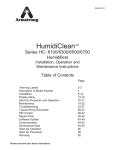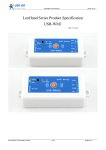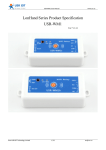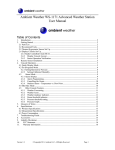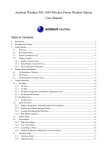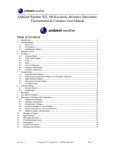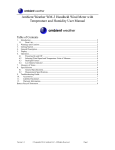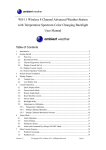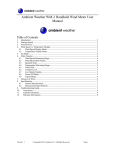Download 5. General Description
Transcript
Ambient Weather WM-35 Handheld Wind Meter with Temperature, Humidity, Barometer User Manual Table of Contents 2. Introduction ..................................................................................................................................... 2 1.1 Parts List................................................................................................................................. 2 3. Warnings and Cautions ................................................................................................................... 2 4. Getting Started ................................................................................................................................ 2 5. General Description ........................................................................................................................ 3 6. Operation......................................................................................................................................... 4 6.1 Powering On and Off ............................................................................................................. 4 6.2 Display Modes........................................................................................................................ 4 6.2.1 Wind Speed ........................................................................................................................ 5 6.2.2 Wind Chill .......................................................................................................................... 5 6.2.3 Relative Humidity .............................................................................................................. 6 6.2.4 Heat Index .......................................................................................................................... 6 6.2.5 Dew Point ........................................................................................................................... 7 6.2.6 Barometric Pressure ........................................................................................................... 7 6.2.7 Pressure Altitude ................................................................................................................ 8 6.3 Min/Max/Avg Mode ............................................................................................................... 8 6.4 Units of Measure .................................................................................................................... 9 6.5 Backlight Feature ................................................................................................................... 9 6.6 Hold Mode.............................................................................................................................. 9 6.7 Calibration Feature ................................................................................................................. 9 6.7.1 Wind Speed Calibration ..................................................................................................... 9 6.7.2 Temperature Calibration ................................................................................................... 10 6.7.3 Humidity Calibration ....................................................................................................... 10 6.7.4 Barometer Calibration ...................................................................................................... 10 6.7.5 Pressure Altitude Calibration ........................................................................................... 11 6.7.6 Special Calibration Notes ................................................................................................. 11 6.8 Low Battery Indicator .......................................................................................................... 13 7. Glossary of Terms ......................................................................................................................... 13 8. Specifications ................................................................................................................................ 14 8.1 General Specifications.......................................................................................................... 14 8.2 Measurement Specifications................................................................................................. 14 9. Troubleshooting Guide.................................................................................................................. 15 10. Accessories ............................................................................................................................... 16 11. Liability Disclaimer .................................................................................................................. 16 12. Warranty Information ............................................................................................................... 16 13. Battery Recycle Statement........................................................................................................ 17 Version 1.2 ©Copyright 2015, Ambient LLC. All Rights Reserved. Page 1 2. Introduction Thank you for your purchase of the Ambient Weather WM-35 Wind Meter with Wind Speed, Temperature, Humidity, Barometer, Wind Chill, Dew Point and Heat Index. The following user guide provides step by step instructions for installation, operation and troubleshooting. To download the latest manual and additional troubleshooting tips, please visit: http://ambientweather.wikispaces.com/wm35 The WM-35 wind meter features: Wind speed in mph, Km/h, m/s, ft/min or Knots Beaufort wind scale bar graph Wind Speed min/max/average selection “Open Air” temperature and humidity sensors for fast response Temperature display in degrees Fahrenheit or Celsius Humidity Wind Chill, Dew Point and Heat Index Barometric Pressure Pressure Altitude LED backlight Wind Speed HOLD feature Low battery display Lanyard included Soft case included Auto power off with override feature Wind speed, temperature and humidity calibration CE Certified & RoHS Compliant 1.1 Parts List QTY 1 1 1 1 1 Item Wind Meter CR2032 3 Volt Lithium Battery Lanyard Soft Carrying Case User Manual 3. Warnings and Cautions Warnings: This meter is accurate at low and mid-range air speeds. Consistent use at very high speeds (example, from the window of a fast moving car) will damage the impeller’s bearing and reduce accuracy. This meter is not a personal safety device 4. Getting Started 1. Open the battery cover, as shown in Figure 1. Turn counter clockwise to open. 2. Inset the included 3V CR2032 lithium cell battery, with the (+) terminal up. Version 1.2 ©Copyright 2015, Ambient LLC. All Rights Reserved. Page 2 3. Replace the cover by turning clockwise. All of the LED segments will briefly light up. Figure 1 5. General Description Figure 2 No 1 2 3 4 5 6 7 8 Version 1.2 Description Vane Impeller (wind speed) Temperature and humidity sensors LCD with backlight Wind Speed Units and temperature selection button Power button Set button Battery cover Lanyard attachment point ©Copyright 2015, Ambient LLC. All Rights Reserved. Page 3 6. Operation Figure 3 6.1 Powering On and Off To power ON the meter, press the after 10 minutes. button. To save power, the meter will power off automatically To override the Auto Power Off, hold down the Set button and then press the button at the same time. The power icon will remain on the display (upper left hand corner) until the batteries run down or the meter is turned off. To power OFF the meter, press and hold the button for two seconds. 6.2 Display Modes Press and hold the SET button for two seconds to change the display modes: Wind Speed -> Wind Chill -> Relative Humidity -> Heat Index -> Dew Point -> Barometric Pressure -> Pressure Altitude Version 1.2 ©Copyright 2015, Ambient LLC. All Rights Reserved. Page 4 6.2.1 Wind Speed Figure 4 No 1 2 3 4 5 Description Wind speed units: m/s, ft/min, knots, km/h, mph MAX: Maximum wind speed recorded while in this mode MIN: Minimum wind speed recorded while in this mode AVG: Average wind speed recorded while in this mode HOLD: Displayed when meter is on hold mode Beaufort scale Wind speed reading based on mode setting 6.2.2 Wind Chill Figure 5 No 1 2 3 4 5 Version 1.2 Description Wind Chill temperature units: °C or °F Max/Min/Avg wind chill temperature reading display HOLD: Displayed when meter is on hold mode Beaufort scale Wind chill reading based on mode setting ©Copyright 2015, Ambient LLC. All Rights Reserved. Page 5 6.2.3 Relative Humidity Figure 6 No 1 2 3 4 5 Description Relative humidity units: %RH Max/Min/Avg relative humidity reading display HOLD: Displayed when meter is on hold mode Beaufort scale Relative humidity reading based on mode setting 6.2.4 Heat Index Figure 7 No 1 2 3 4 5 Version 1.2 Description Heat Index Temperature units: °C or °F Max/Min/Avg wind chill temperature reading display HOLD: Displayed when meter is on hold mode Beaufort scale Heat index reading based on mode setting ©Copyright 2015, Ambient LLC. All Rights Reserved. Page 6 6.2.5 Dew Point Figure 8 No 1 2 3 4 5 Description Dew Point Temperature units: °C or °F Max/Min/Avg dew point temperature reading display HOLD: Displayed when meter is on hold mode Beaufort scale Dew Point reading based on mode setting 6.2.6 Barometric Pressure Figure 9 Version 1.2 ©Copyright 2015, Ambient LLC. All Rights Reserved. Page 7 No 1 2 3 4 5 Description Barometric pressure units: hpa, mbar, inHg Max/Min/Avg dew pressure reading display HOLD: Displayed when meter is on hold mode Beaufort scale Barometric pressure reading based on mode setting 6.2.7 Pressure Altitude Figure 10 No 1 2 3 4 Description Pressure Altitude units: m, ft Max/Min/Avg density altitude reading display Beaufort scale Pressure altitude reading based on mode setting 6.2.7.1 Relative Altitude (Ascent) To view the relative altitude, or the change in altitude since last calibrated (referred to as climb or ascent / descent), press and hold the Units button for two seconds, and relative altitude will be displayed. Press and hold the Units button again for two seconds to change back to Density Altitude. 6.3 Min/Max/Avg Mode While the meter is powered up, press the button to view the maximum value recorded since the meter was powered up. The MAX icon will be displayed. Press the button again to view the minimum value recorded since the meter was powered up. The MIN icon will be displayed. Press the button again to view the average value recorded since the meter was powered up. The AVG icon will be displayed. Version 1.2 ©Copyright 2015, Ambient LLC. All Rights Reserved. Page 8 Press the button again to view the current measured value. 6.4 Units of Measure Press the Units button to change the units of measure of the measurement currently displayed. 6.5 Backlight Feature The backlight will automatically turn on then you press any button. The backlight will automatically turn off after 10 seconds of inactivity to save battery life. 6.6 Hold Mode The purpose of the Hold mode is to hold the measured value in the event you cannot read the display when taking a measurement (example, inside a duct). To enter the HOLD mode, press and hold the Units button for two seconds. The HOLD icon will be displayed. To exit the HOLD mode, press and hold the Set button for two seconds, and the hold icon will disappear. NOTE: This function is different for altitude. Refer to Section 6.2.7.1 for details. 6.7 Calibration Feature Note: Read Section 6.7.7 first before performing any calibration. Note: Each time you enter the calibration mode for a particular measurement, it will display the default measured value. Note: Dew Point, Heat Index and Wind Chill are calculated parameters, and cannot be calibrated directly, and are based on the calibrated temperature, humidity and wind speed measurements. 6.7.1 Entering the Calibration Mode The calibration feature supports wind speed (Mode 1), temperature (Mode 2), humidity (Mode 3), barometer (Mode 4) and density altitude (Mode 5) calibration. With the meter powered off, press and hold the Units and enter the calibration mode. 6.7.2 button at the same time for one second to Wind Speed Calibration The wind speed calibration uses a multiplier, where: Calibrated wind speed = Wind Speed Multiplier x Measured wind speed. Example: If the measured wind speed is 10 mph, and the calibrated wind speed is 13 mph, the Wind Speed multiplier is 1.3, or: 13 mph = 1.3 x 10 mph Version 1.2 ©Copyright 2015, Ambient LLC. All Rights Reserved. Page 9 With the meter powered off, press and hold the Units and then the the calibration mode. The number “1” will be displayed. Press the button at the same time to enter button to continue with the wind speed calibration. x0.1 units of wind speed will flash. Press Set to adjust. Press Units button and x1 units of wind speed will flash. Press Set to adjust. To exit the calibration mode at any time, press the 6.7.3 button, and the meter will power off. Temperature Calibration With the meter powered off, press and hold the Units button and then the button at the same time to enter the calibration mode. Press the Units button, and the number “2” will be displayed. Press the button to continue with the temperature calibration. x0.1 units of temperature will flash. Press Set to adjust. Press Units button and x1 units of temperature will flash. Press Set to adjust. Press Units button and x10 units of temperature will flash. Press Set to adjust. To exit the calibration mode at any time, press the 6.7.4 button, and the meter will power off. Humidity Calibration With the meter powered off, press and hold the Units button and then the button at the same time to enter the calibration mode. Press the Units button twice and the number “3” will be displayed. Press the button to continue with the humidity calibration. x0.1 units of humidity will flash. Press Set to adjust. x1 units of humidity will flash. Press Set to adjust. Press Units button and x10 units of humidity will flash. Press Set to adjust. To exit the calibration mode at any time, press the 6.7.5 button, and the meter will power off. Barometer Calibration With the meter powered off, press the Units button and then the button at the same time to enter the calibration mode. Press the Units button three times and the number “4” will be displayed. Press the button to continue with the barometer calibration. x0.01 units of barometer will flash. Press Set to adjust. Press Units button and x0.1 units of barometer will flash. Press Set to adjust. Press Units button and x1 units of barometer will flash. Press Set to adjust. Press Units button and x10 units of barometer will flash. Press Set to adjust. To exit the calibration mode at any time, press the Version 1.2 button, and the meter will power off. ©Copyright 2015, Ambient LLC. All Rights Reserved. Page 10 6.7.6 Pressure Altitude Calibration With the meter powered off, press the Units button and then the button at the same time to enter the calibration mode. Press the Units button four times and the number “5” will be displayed. Press the button to continue with the density altitude calibration. X1 units of density altitude will flash. Press Set to adjust. Press Units button and x10 units of density altitude will flash. Press Set to adjust. Press Units button and x100 units of density altitude will flash. Press Set to adjust. Press Units button and x1000 units of density altitude will flash. Press Set to adjust. To exit the calibration mode at any time, press the 6.7.7 button, and the meter will power off. Special Calibration Notes 6.7.7.1 Temperature Temperature errors can occur when a sensor is placed too close to a heat source (such as your body temperature). To calibrate temperature, we recommend a mercury or red spirit (fluid) thermometer. Bi-metal (dial) and digital thermometers (from other weather stations) are not a good source and have their own margin of error. Using a local weather station in your area is also a poor source due to changes in location, timing (airport weather stations are only updated once per hour) and possible calibration errors (many official weather stations are not properly installed and calibrated). Place the sensor in a shaded, controlled environment next to the fluid thermometer, and allow the sensor to stabilize for 48 hours. Compare this temperature to the fluid thermometer and adjust the console to match the fluid thermometer. 6.7.7.2 Humidity Humidity is a difficult parameter to measure electronically and drifts over time due to contamination. In addition, location has an adverse affect on humidity readings (measuring over dirt vs. lawn for example). Official stations recalibrate or replace humidity sensors on a yearly basis. Due to manufacturing tolerances, the humidity is accurate to ± 5%. To improve this accuracy, the indoor and outdoor humidity can be calibrated using an accurate source, such as a sling psychrometer or humidipack. Another low cost method is the saturated salt test. For more information, visit: http://ambientweather.wikispaces.com/wm35 6.7.7.3 Wind Speed Impeller bearings (moving parts) wear over time. Without a calibrated source, wind speed can be difficult to measure. We recommend using a calibrated wind meter (available from Ambient Weather) and a constant speed, high speed fan, or an accredited wind tunnel. Do not attempt to calibrate in a moving vehicle. The constant high speed may damage the impeller. Version 1.2 ©Copyright 2015, Ambient LLC. All Rights Reserved. Page 11 6.7.7.4 Barometer The most frequently asked question about the barometric pressure is ‘why do I need to calibrate the barometer?’ The answer is based on how you use the meter, and your specific application. If you use it to hike or travel, and your barometric pressure is changing due to altitude, you do not want to calibrate the pressure and are likely interested in the measured or absolute pressure. If you are tuning your race car at a track, or your RC plane, air density is important and this is based on measured or absolute pressure. If you are stationary, and use the barometer to monitor changes in the weather, then you are likely interested in relative pressure, or barometer corrected to sea-level. The following is a brief discussion on absolute (measured) pressure vs. relative (corrected to sea-level) pressure. The measured barometer is referred to as absolute pressure. This meter displays absolute pressure. To compare pressure conditions from one location to another, meteorologists correct pressure to sea-level conditions (referred to as relative pressure). Because the air pressure decreases as you rise in altitude, the relative pressure (the pressure your location would be at if located at sea-level) is generally higher than your absolute pressure. Thus, your absolute pressure may read 28.62 inHg (969 mb) at an altitude of 1000 feet (305 m), but the relative pressure is 30.00 inHg (1016 mb). The standard relative pressure is 29.92 in Hg (1013 mb). This is the average relative pressure around the world. Relative pressure conditions greater than 29.92 inHg (1013 mb) are considered high pressure and less than are considered low pressure. Most weather stations instruct you to find a reporting station near your location to identify the relative pressure. A good source is Wunderground.com. If you correct your pressure to sea-level (relative pressure), if you change locations or altitude, you will have to calibrate the relative pressure again. 6.7.7.5 Pressure Altitude Altimeters are often misunderstood because they do not measure your actual position on the earth (true altitude) such as a GPS, but measure the air pressure and predict the altitude based on this measurement. This is referred to as “Pressure Altitude”. Pressure Altitude is adversely affected by the true altitude and to a lesser extent, changes in the weather, often referred to as barometric pressure changes. Thus, your Pressure Altitude can change without changing your position. These changes can be as great as a thousand feet (the changes due to weather are more pronounced at higher altitude). To offset the difference between Pressure Altitude and True Altitude, you must calibrate the device at a Version 1.2 ©Copyright 2015, Ambient LLC. All Rights Reserved. Page 12 known altitude, whenever convenient. 6.8 Low Battery Indicator If the low battery indictor is present , or there is no LCD display, it is time to change the battery. 7. Glossary of Terms Term Accuracy Beaufort Scale Dew Point Heat Index Definition Accuracy is defined as the ability of a measurement to match the actual value of the quantity being measured. The Beaufort Scale is an empirical measure for describing wind speed based mainly on observed sea conditions (on land it is categorized by the physical effects it has on vegetation and structures). Its full name is the Beaufort Wind Force Scale. The dew point is the temperature at which a given parcel of humid air must be cooled, at constant barometric pressure, for water vapor to condense into water. The condensed water is called dew. The dew point is a saturation temperature. The dew point is associated with relative humidity. A high relative humidity indicates that the dew point is closer to the current air temperature. Relative humidity of 100% indicates the dew point is equal to the current temperature and the air is maximally saturated with water. When the dew point remains constant and temperature increases, relative humidity will decrease. The Heat Index, sometimes referred to as the apparent temperature, is a measure of how hot it really feels when relative humidity is factored with the actual air temperature. To find the Heat Index temperature, look at the Heat Index chart below. As an example, if the air temperature is 96°F and the relative humidity is 65%, the heat index (how hot it feels) is 121°F. IMPORTANT: Since heat index values were devised for shady, light wind conditions, exposure to full sunshine can increase heat index values by up to 15°F. Also, strong winds, particularly with very hot, dry air, can be extremely hazardous. The Heat Index Chart shaded zone above 105°F shows a level that may cause increasingly severe heat disorders with continued exposure or physical activity. Measured Pressure or Absolute Pressure Pressure Altitude Range Resolution Sea-level Pressure or Relative Pressure Version 1.2 Heat Index is not calculated below 80°F. Absolute pressure is the barometric pressure measured at your location. The Absolute pressure is adversely affected by altitude, and to a lesser extent, changes in the weather. Pressure Altitude is the altitude in the International Standard Atmosphere (an atmospheric model of how the pressure changes over a wide range of altitudes), calculated from the measured air pressure. Range is defined as the amount or extent a value can be measured. Resolution is defined as the number of significant digits (decimal places) to which a value is being reliably measured. Sea-level Pressure is the relative pressure measured at your location, compensated to sea-level. To compare pressure conditions from one location to another, meteorologists correct pressure to sea-level conditions. ©Copyright 2015, Ambient LLC. All Rights Reserved. Page 13 Term True Altitude Definition True altitude is the elevation above mean sea level. To measure true altitude, you must know your exact position on the earth, as measured by a GPS. An altimeter measures pressure altitude. The Beaufort Scale is displayed on the top and left side of the display, and is defined as follows: No 0 1 2 3 4 5 6 7 8 9 10 11 12 Description Calm Light air Light breeze Gentle breeze Moderate breeze Fresh breeze Strong breeze Near gale Gale Strong gale Storm Violent storm Hurricane force m/s 0-0.2 0.3-1.5 1.6-3.3 3.4-5.4 5.5-7.9 8.0-10.7 10.8-13.8 13.9-17.1 17.2-20.7 20.8-24.4 24.5-28.4 28.5-32.6 〉32.6 kts 0-1 1-3 4-6 7-10 11-16 17-21 22-27 28-33 34-40 41-47 48-55 56-63 >63 mph 0-1 1-3 4-7 8-12 13-18 19-24 25-31 32-38 39-46 47-54 55-63 64-72 >72 km/h 0-1 1-5 6-11 12-19 20-28 29-38 39-49 50-61 62-74 75-88 89-102 103-117 >117 ft/min 0-58 59-314 315-668 669-1082 1083-1574 1575-2125 2126-2735 2736-3385 3386-4093 4094-4822 4823-5609 5610-6417 >6417 8. Specifications 8.1 General Specifications Wind Speed Update Interval: 0.5 seconds Temperature Update Interval: 0.1 seconds Humidity Update Interval: 1 second Power Source: 1 x 3V lithium cell (CR2032) Battery Life: About 1 year under normal usage, accelerated if power on is overridden. Dimensions (L x W x H): 1.6” x 0.75” x 4.5” (40 x 19 x 115 mm) 8.2 Measurement Specifications The following table provides specifications for the measured parameters. Measurement Wind speed Wind chill Temperature Relative humidity Heat index Dew point Version 1.2 Units m/s ft/min knots km/h mph o C o F o C o F %RH o C o F o C o F Range 0 to 30 0 to 5860 0 to 55 0 to 90 0 to 65 0 to 30m/s, -45 to 10 0 to 65 mph, -49 to 50 -29 to 70 -20 to 158 0 to 100 0 to 100%RH,21.1 to 54.4 0 to 100%RH,70 to 130 -29 to 70 -20 to 158 Resolution 0.1 19 0.2 0.3 0.2 0.1 0.1 0.1 0.1 0.1 0.1 0.1 0.1 0.1 ©Copyright 2015, Ambient LLC. All Rights Reserved. Accuracy ±5% 1 1.8 1 1.8 ±3% 2 3.6 2 3.6 Page 14 hpa mbar inHg m ft Barometric pressure Altitude Other specifications: Battery Operating temperature Storage temperature Operating humidity Storage humidity Current consumption Weight 10 to 1100 10 to 1100 0.29 to 32.48 -700 to 9000 -6000 to 30000 0.1 0.1 0.01 1 1 1.5 1.5 0.05 12 50 CR2032 2.0V -10 ~ 50°C (14 ~ 122℉) -10 to 60oC(14 to 140oF) 10 to 90% RH ≤ 75% About 2.5mA (5mA with backlight on) 60g 9. Troubleshooting Guide To download the latest manual and additional troubleshooting tips, please visit: http://ambientweather.wikispaces.com/wm3 If your question is not answered here, you can contact us as follows: 1. Email Support: [email protected] 2. Technical Support: 480-346-3398 (M-F 8am to 4pm Arizona Time) Problem Solution It is normal for the impeller to oscillate as it comes to a stop, and it is not imbalanced. The meter contains a very small magnet that responds to the earth’s magnetic fields. This does not affect the accuracy of the wind speed readings and only appears when breaking or accelerating. This is normal for the vane to vibrate at high speed. Do not operate above 67 mph. Above 67 mph, the meter will display ---. The LCD display will not operate below approximately 14 °F. Use the warmth of your body or environment for use in cold weather conditions, or Battery is dead. Replace the battery. Impeller appears imbalanced. Vane is noisy at high speed. Display is dim or disappears. 1. The Version 1.2 ©Copyright 2015, Ambient LLC. All Rights Reserved. Page 15 10. Accessories The following software and hardware accessories are available for this weather station at www.AmbientWeather.com . Accessory Ambient Outdoors CR2032 3 Volt Lithium Button Cell Battery Description Standard CR2032 3 Volt Lithium Battery (1 battery) 11. Liability Disclaimer Please help in the preservation of the environment and return used batteries to an authorized depot. The electrical and electronic wastes contain hazardous substances. Disposal of electronic waste in wild country and/or in unauthorized grounds strongly damages the environment. Reading the “User manual” is highly recommended. The manufacturer and supplier cannot accept any responsibility for any incorrect readings and any consequences that occur should an inaccurate reading take place. This product is designed for use in the home only as indication of weather conditions. This product is not to be used for medical purposes or for public information. The specifications of this product may change without prior notice. This product is not a toy. Keep out of the reach of children. No part of this manual may be reproduced without written authorization of the manufacturer. Ambient, LLC WILL NOT ASSUME LIABILITY FOR INCIDENTAL, CONSEQUENTIAL, PUNITIVE, OR OTHER SIMILAR DAMAGES ASSOCIATED WITH THE OPERATION OR MALFUNCTION OF THIS PRODUCT. 12. Warranty Information Ambient, LLC provides a 1-year limited warranty on this product against manufacturing defects in materials and workmanship. This limited warranty begins on the original date of purchase, is valid only on products purchased and only to the original purchaser of this product. To receive warranty service, the purchaser must contact Ambient, LLC for problem determination and service procedures. Warranty service can only be performed by a Ambient, LLC. The original dated bill of sale must be presented upon request as proof of purchase to Ambient, LLC. Your Ambient, LLC warranty covers all defects in material and workmanship with the following specified exceptions: (1) damage caused by accident, unreasonable use or neglect (lack of reasonable and necessary maintenance); (2) damage resulting from failure to follow instructions contained in your owner’s manual; (3) damage resulting from the performance of repairs or alterations by someone other than an authorized Ambient, LLC authorized service center; (4) units used for other than hobbyist use (5) applications and uses that this product was not intended and (6) extreme acts of nature, such as lightning strikes or floods. This warranty covers only actual defects within the product itself, and does not cover the cost of Version 1.2 ©Copyright 2015, Ambient LLC. All Rights Reserved. Page 16 installation or removal from a fixed installation, normal set-up or adjustments, claims based on misrepresentation by the seller or performance variations resulting from installation-related circumstances. 13. Battery Recycle Statement Recycle Batteries Recycle your old batteries at one of the many collection sites in the U.S. and Canada. To find the site nearest you, visit www.call2recycle.org or call toll-free 1-877-2-RECYCLE. Version 1.2 ©Copyright 2015, Ambient LLC. All Rights Reserved. Page 17

















